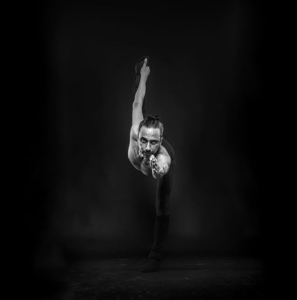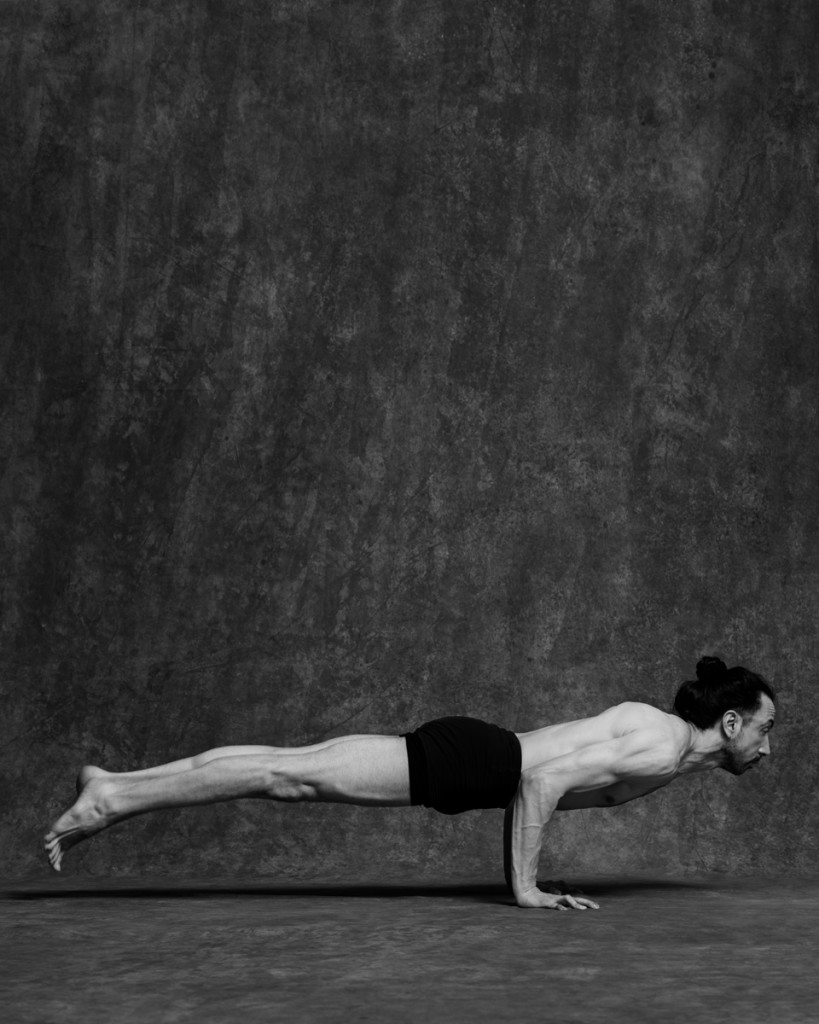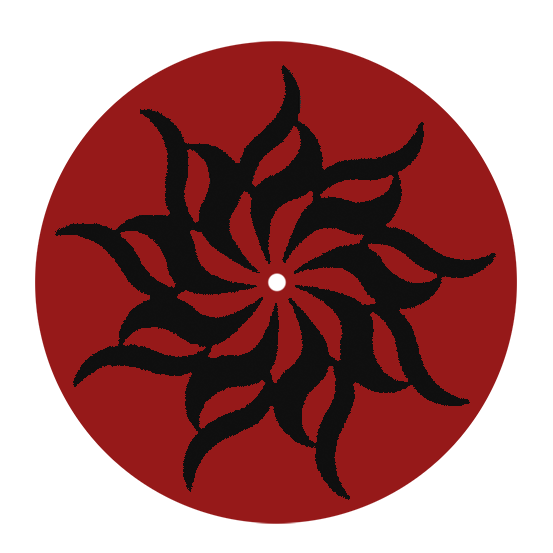Ekapāda Satyāsana (one-leg Goddess Sati pose)

Dario Calvaruso photographed by Siuman Yuen
Ekapāda Satyāsana (one-leg Goddess Sati pose)
Dario Calvaruso preparing Carol for Vālgudāsana.
Dario Calvaruso preparing Carol for Vālgudāsana. At difference from the dvipādika śīrṣāsana the Vālgudāsana has perfect symmetry between right-and-left, the sole of the foot are flat and the rotation of the hip is wider.
Preparing yoga students for the cakrāsana (wheel).
Dario Calvaruso preparing Carol for the cakrāsana (wheel).
Here Carol’s first very attempt. Advance poses should be achieved only after conditioning. The cakrāsana conditioning prepares the practitioner in achieving the posture with no stress on the shoulders and wrist. It is about achieving anterior stretch (not a back bend). Knees should kept straight and one should not drop on the floor. Drop-back is very harmful for the wrist, shoulder and back/spine.
The dvyāṅga-makarāsana (two limbs crocodile pose)
The dvyāṅga-makarāsana (two limbs crocodile) is the caturāṅga makarāsana at the extreme. It emphasises the full engagement of the upper body (arm, chest and core rather than shoulders). If the elbows are kept at 90° their no strain on the shoulder and wrist’s joints. The body is not supported by the elbows but by the whole-body-strength. As the caturāṅga makarāsana is frequently wrongly called caturāṅga daṇḍāsana it is also important to distinguish the two. The caturāṅga makarāsana (or the four limbs crocodile pose) has the elbows at 90° and the body is parallel to the floor. While the caturāṅga daṇḍāsana (or the four limbs stuff pose) has straighten elbows/arms and it is inclined from the shoulder down towards the feet). The most common mistake in the caturāṅga makarāsana is creating a 75-45°angle on the elbows which bring heaviness on the shoulders and wrists and gradually deteriorate the joints.

Chāyācitra-Yoga (छायाचित्र–योग) – “The Yoga of Photography”
Dario Calvaruso by Richard Pilnick
© All rights reserved
Karaṇas – On: Immediateness, Promptness, Confidence and Control
Shanghai, January 2016
PURE YOGA IAMP – Intro to Karaṇa
On Immediateness, Promptness, Confidence and Control
Reading śavāsana
In the Navakaraṇa Vinyāsa the śavāsana is not a merely an “āsana” but the “phalaprāpti kriyā” (lit. action for getting the results). The quality of the practice is clearly evident by observing the practitioners during the śavāsana. If the practitioners are really disconnected from their body, mind and senses and fully absorbed into the final stage of the laya (lit. absorption) it means that the navakarṇa vinyāsa gave its delicious fruit.
Video taken during the the first session of Navakarṇa Vinyāsa Maṇḍala Complimentary Workshop at The Centrium, Pure Yoga, Hong Kong.
Tutorial: Makara Karaṇa and the ūrdhva mukha śvāna karaṇā
How to perform the Caturāṅga Makara Karaṇa and the Ūrdhva Mukha Śvāna Karaṇā in the Navakaraṇa Vinyāsa method.
These are the two units of movement which occur from Caturāṅga Daṇḍāsana to Ūrdhva Mukha Śvānāsana
It is the fundamental transition to maintain both alignment in the posture and also alignment in the vinyāsa. Many students find quite difficult to perform it correctly with proper alignment. This video will help you to have a clear understanding of the transition.
Caturāṅga Daṇḍāsana is performed by
straightening the whole body from head of the heels to bottom of the neck. Make sure you do not arch your spine or raise the hips up to the shoulders feet are perpendicular to the floor pressing on the first line
hands with pressure on first and second line, the third and fourth line are also engaged partially (pls check my other videos for feet and hands grip and alignments). You can look straight ahead (samadṛṣṭi) or at the tips of your nose (nāsāgre dṛṣṭi). With exhalation you enter Caturāṅga Makarāsana
Caturāṅga Makarāsana is performed
while keeping your whole body in a straighten line parallel to the floor and bending the elbows to 90 degree angle. You want to engage fully your core and avoid to strain your shoulders’ joints so do not bend the elbow more than 90 degree. The focus point of your eyes is still the same of the Caturāṅga Daṇḍāsana. As you start the inhalation you enter Utthita Makarāsana
Utthita Makarāsana is performed by rolling the tips of your toes backwards, shifting your body-weight on your arms and dragging the hips forwards. At this time you shift the focus of your eyes between the eyebrows (bhrūmadhye dṛṣṭi ). As your lungs are almost full you enter Ūrdhva Mukha Śvānāsana
Ūrdhva Mukha Śvānāsana is performed by dragging the hips between the forearm and raising the chin upwards towards the sky
the focus gaze remains between the eyebrows (bhrūmadhye dṛṣṭi)
As soon you complete the inhalation you contract the CP muscle and pull the muscles up towards the root of the spine. This called mūla prāṇa-ādhāra-prayoga (engagement of root pranic centre). Do not confuse it with mūla bandha as many partitioner do.
https://www.facebook.com/navakaranavinyasa
www.navakaranavinyasa.com
Alignment between Vinyāsas
In the Navakaraṇa Vinyāsa we do not have only “postural alignments (āsana)” but also alignment between postures and the vinyāsa. It is called karaṇa or unit of movement. For instance if you move your hands from sālamba śīrṣāsana or mayurāsana to a tripod in order to drop your feet and continue the vinyāsa (as we see many times) you have lost the alignment between the posture and the vinyāsa. Here a short video taken from Cassie during last workshop. Units of movement between sālamba śīrṣāsana to mayurāsana to utthita mayurāsana to adho mukha śvanāsana.
Handstand (ūrdhva mūla vṛkṣasana) with Dario Calvaruso
name: ūrdhva mūla vṛkṣasana (inverted tree-pose, lit. tree rooted up) or adho mukha vṛkṣasana (facing down tree-pose)
vibhāga: I-IV[6]V-VI
Open headstand (muktahasta śīrṣāsana) with Dario Calvaruso
name: muktahasta śīrṣāsana
vibhāga: I-IV[3]V-VI
Tripod Headstand (karadhṛta śīrṣāsana) with Dario Calvaruso
name: karadhṛta śīrṣāsana (lit. head-pose supported by the hand)
vibhāga: I-IV[6]V-VI
adho mukha and ūrdhva mukha mayurāsana (peacock pose) with Dario Calvaruso
name: adho mukha / ūrdhva mukha mayurāsana (peacock pose)
vibhāga: I-IV[3]V-VI
Fastened Headstand (baddha śīrṣāsana) with Dario Calvaruso
name: baddha śīrṣāsana
vibhāga: I-IV[6]V-VI
vinyāsa advanced flow
Advanced updakrama in navakaraṇa vinyāsa with Dario Calvaruso. The upakrama (pre-sequence or warm up) is built in 18 matra-s, 3 breaths / 6 mantra-s for entering the posture (adho mukhā śvānāsana / downward facing dog posture), 3 breaths / 6 matra-s in the posture and 3 breaths / 6 mantra-s to exit the posture.
The five basic technique of drag and float for the warm-up (upakrama)
This five techniques of flowing and floating:
These technique should be learn progressively with the following order:
– gentle press and drag
– gentle press and jump into nirālamba bakāsana
– press and jump to ardha adho mukha vṛkṣāsana
– press and jump to adho mukha vṛkṣāsana
– press to adho mukha vṛkṣāsana
